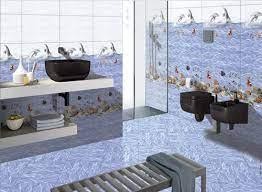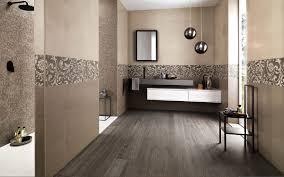
When it comes to selecting bathroom tiles, the style and feel you want is entirely determined by the tiles you choose. The bathroom is a vital part of the house, used regularly by families and guests. It may seem to be a daunting experience, given the almost limitless variety of colors, sizes, designs, forms, finishes, and materials available. With our extensive expertise and understanding in the tile and stone sector, we can advise you on all aspects of bathroom tile selection.
No. 1 Tip: COMPLETE YOUR HOMEWORK
When it comes to selecting bathroom tiles, it’s important to understand the various kinds of materials and their intended uses. The following are the most often used tile kinds in bathrooms:
Decorative ceramic tiles:
Ceramic or non-porcelain tiles are ideal for kitchens, baths, basements, porches, laundries, powder rooms, and other spaces that are prone to dampness. Ceramic bathroom tiles are often constructed of red, brown, or white clay that is baked in a kiln and coated with a durable glaze that carries the tile’s color and design. The glazed surface of the tile creates a solid, non-porous surface that is stain, fire, and slide resistant. Ceramic floor bathroom tiles are appropriate for bathrooms with low to moderate activity, although they are susceptible to wear and chipping.
Due to the high water absorption rate of ceramic bathroom tiles, the surface is immune to water penetration and stains. Today’s ceramic tiles are available in matt, satin, gloss, and polish finishes, providing you with an infinite number of alternatives for the walls and floors of your bathroom. Ceramic bathroom tiles are very simple to maintain and clean. When properly maintained, ceramic floor tiles are one of the most durable materials available today.
Porcelain tiles

Porcelain bathroom tiles provide significant design benefits; their robust nature enables limitless possibilities for indoor and external uses. The color and design are carried throughout the thickness of the porcelain tile, making it a considerably tougher and denser tile. Porcelain tiles are ideal for use on walls and floors in commercial and high-traffic areas of the house. Porcelain floor bathroom tiles are ideal for bathrooms due to their resistance to wear and tear in places with heavy usage from families and pets. Porcelain floor bathroom tiles provide a durable surface that is stain and scratch-resistant and simple to clean and maintain.
Natural stone tiles
If you’re looking for a more natural earthy vibe, there are a plethora of natural stone tile possibilities. Marble, limestone, travertine, slate, and granite are the most often used natural stone tiles. It is important to remember that natural stone bathroom tiles are porous, which means they may absorb water, lubricants, and stains when exposed to them for extended periods of time.
Sealing your tile immediately after installation and performing routine maintenance, such as sealing, will keep your stone looking faultless and prevent stains or surface damage. A seal acts as a barrier between water and the stone, preventing liquids from seeping into the surface and extending the life of the stone. Because the earth is one of the greatest material producers, you have assured a durable surface that is also visually beautiful. Because the distinctive pattern of real stone changes from tile to tile, no two natural stone tile surfaces will be identical. It is critical to avoid bleaches and other harsh chemicals on a natural stone since they have a tendency to eat through the surface.
Tile mosaics
Mosaic tiles are an excellent way to add a distinctive element to any bathroom tiles decor. The limitless possibilities in terms of color, design, and size will definitely mesmerize you. While there is no doubting the beauty of mosaic floor tile, they may be rather slippery when wet. When selecting mosaic bathroom tiles for your bathroom floor, make careful to verify the slip resistance rating and guarantee. While glass mosaic tiles are reasonably simple to clean, keep in mind that the more grout lines there are, the more cleaning is required!
No. 2 Tip: Slip Resistance Ratings
When it comes to picking bathroom tiles for moist areas, the variety of alternatives might be bewildering. The possibilities for colors, sizes, and finishes are unlimited! However, the trick is to choose a tile with a high slip rating. Tiles are subjected to a slip rating test, which evaluates the surface’s frictional characteristics in order to determine which are the most suitable for various climatic circumstances. The test determines the long-term wear characteristics of a floor throughout its expected life, taking into account the installation procedure, wear characteristics, cleaning maintenance, and projected traffic. Use the chart below to assist you in selecting tiles for household or commercial use. Visit http://bobgraytileandflooring.com/how-to-revamp-the-look-of-your-bathroom-tiles/ to read about How to revamp the look of your bathroom tiles.
- PEI Class 1 Rating (no foot traffic) – Recommended for residential and commercial wall installations only.
- PEI Class 2 (Light traffic) – Recommended for use on both walls and bathroom floors.
- PEI Class 3 (Light to Moderate Activity) – Recommended for counters, walls, and floors that will see moderate foot traffic.
- PEI Class 4 (moderate to high traffic) – Recommended for all residential, medium commercial, and light institutional applications.
- PEI Class 5 (high to very heavy traffic) – Recommended for all residential, commercial, and institutional applications. The majority of porcelain tiles have a PEI rating of 5, making them the most durable tiles on the market.
Tip No. 3: Choosing the appropriate tile size
When designing a bathroom, a good rule of thumb is to start with the room’s dimensions. Large-format tiles look fantastic on both walls and floors, providing a faultless finish to a large bathroom. However, for smaller bathroom spaces, we recommend adding a feature like penny rounds or mosaic tiles.
If you’re working with a little amount of space, an enlarged diamond pattern on the bathroom floor may generate diagonal lines that offer the eye a longer route to follow from one side of the room to the other, creating the illusion of a larger room. While it may seem counterintuitive, selecting bigger tiles for a tiny bathroom works because the grouted seams are minimized, creating the appearance of greater space.
Large format bathroom tiles are ideal for accentuating a bathroom’s size and making it seem stretched. At Italia Ceramics’ tile shop in Adelaide, we sell a large selection of floor tiles in a number of sizes to guarantee that the proper size, color, and finish fit your bathroom. However, it does not end there. When selecting shower tiles, keep in mind the kind of drains that will be put in the bathroom. If you use large tiles in a small bathroom, you will notice that more grout lines are necessary for the shower, which tends to seem untidy and cluttered.
If you use strip drains in your shower, any tile, large or tiny, irregular, square, or rectangular, even huge format tiles, will operate harmoniously, allowing you to maintain your aesthetic objectives! Strip drains are popular because they are inconspicuous and needless grout tiles, which results in less grout cleaning. We suggest that you consult with your tiler before committing to a tile that may not be appropriate for your bathroom.
